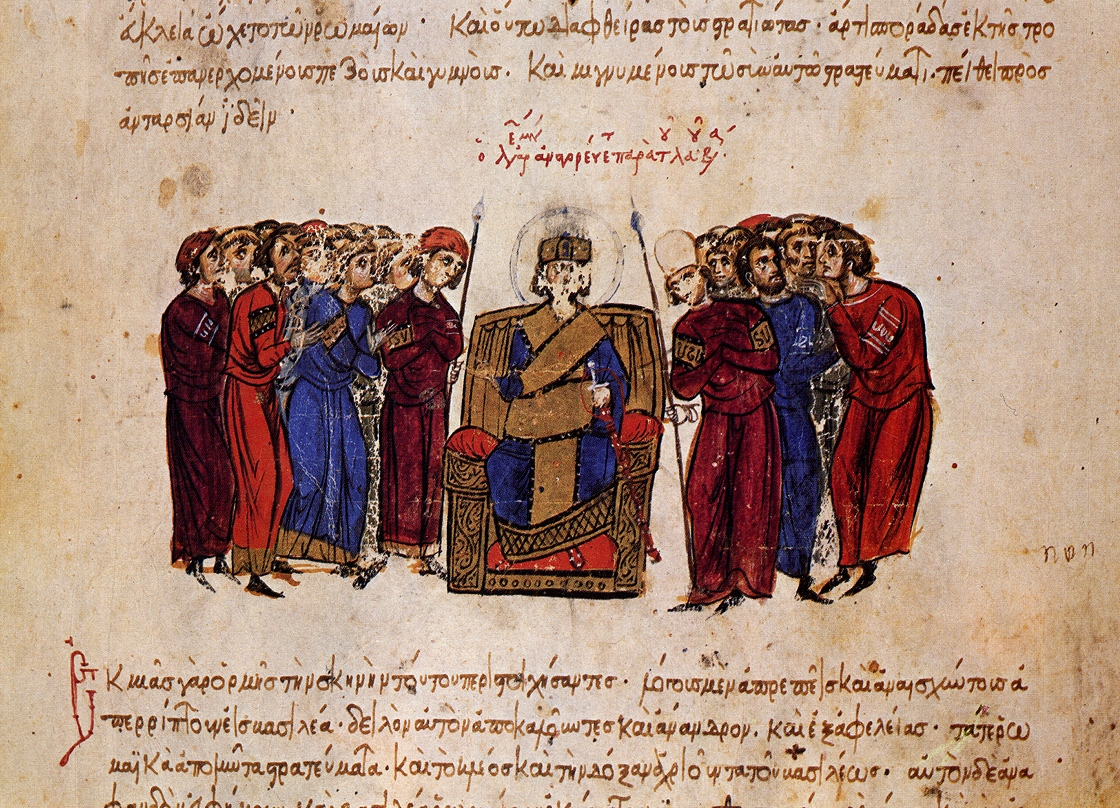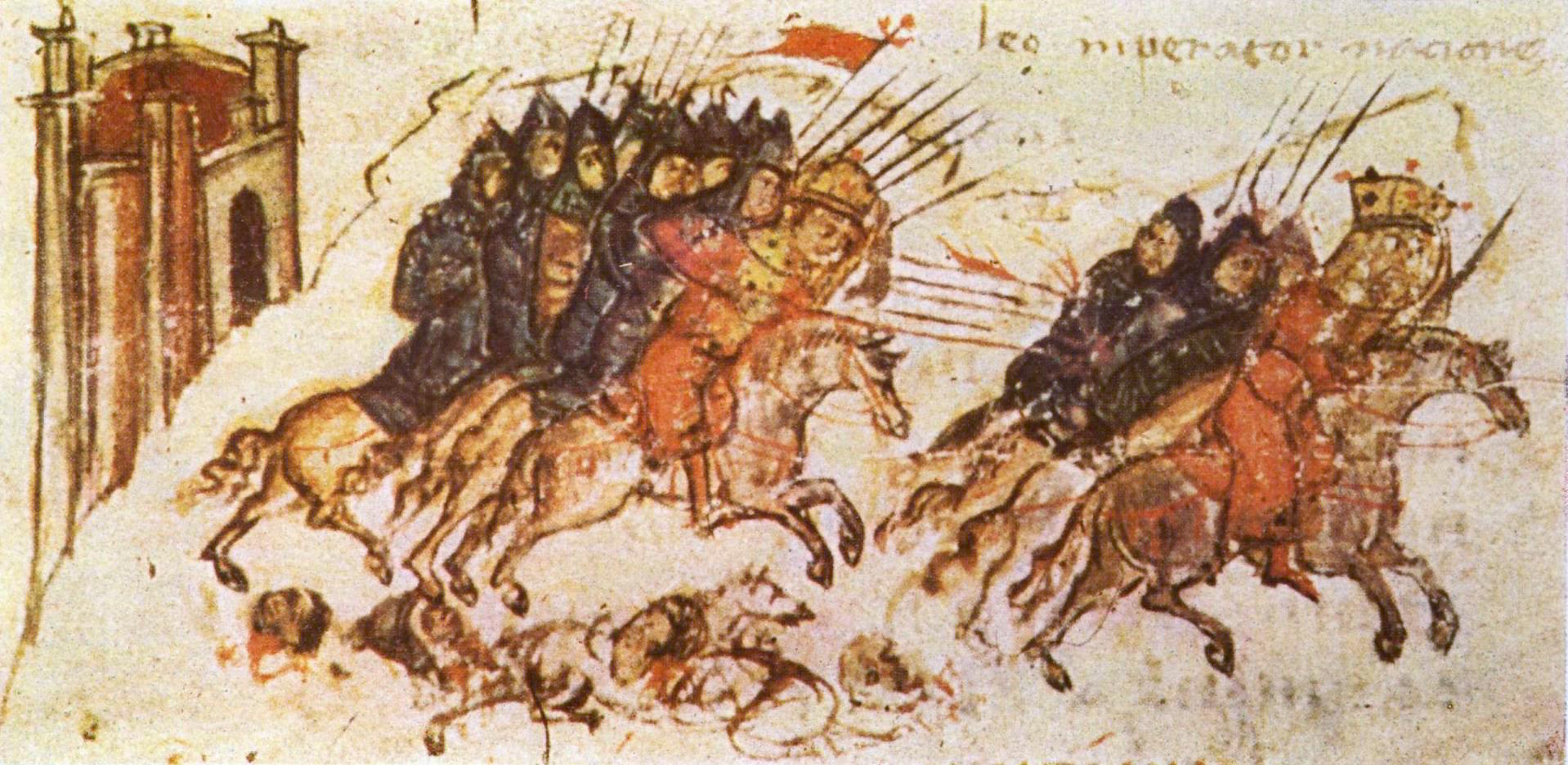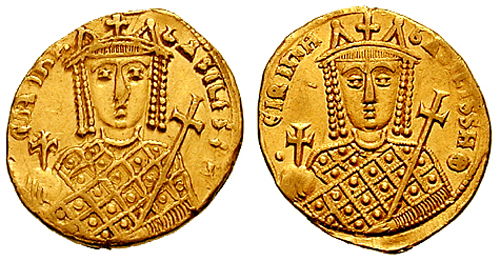|
Leo The Armenian
Leo V the Armenian (, ''Léōn ho Arménios''; 775 – 25 December 820) was the Byzantine emperor from 813 to 820. He is chiefly remembered for ending the decade-long war with the Bulgars, as well as initiating the second period of Byzantine iconoclasm. A senior general of Armenian origin, Leo distinguished himself under Nikephoros I and Michael I Rhangabe, eventually becoming the '' stratēgos'' of the Anatolic Theme. Taking advantage of Michael's defeat at the Battle of Versinikia, he forced the emperor to abdicate in his favour. He was able to withhold the blockade of Constantinople by Krum of Bulgaria and, after Krum's death, concluded a 30-year peace with his successor Omurtag. In 815, Leo deposed Patriarch Nikephoros and reinstituted iconoclasm. He was assassinated by supporters of Michael the Amorian, one of his most trusted generals, who succeeded him on the throne in 820. Background Leo was born in Umayyad Arminiya, the son of the patrician Bardas, who was of A ... [...More Info...] [...Related Items...] OR: [Wikipedia] [Google] [Baidu] |
Madrid Skylitzes
The ''Madrid Skylitzes'' is a 12th-century illuminated manuscript version of the ''Synopsis of Histories'' () by John Skylitzes, which covers the reigns of the Byzantine emperors from the death of Nicephorus I in 811 to the deposition of Michael VI Bringas, Michael VI in 1057. The manuscript was produced at the Norman court of Palermo in Sicily (although there is some debate on whether the main body was made in Palermo or Constantinople) and is now housed in the Biblioteca Nacional de España in Madrid. It remains the only preserved Greek-language illustrated chronicle from the Byzantine period. The chronicle includes 574 Miniature (illuminated manuscript), miniatures detailing depictions of everyday life in the Byzantine Empire such as boats, literary practices, sieges, and ceremonies, in "both purely Byzantine illuminated manuscripts, Byzantine and Western styles while also reflecting Islamic miniature, Islamic elements".Helen C. Evans, Evans, Helen C. & Wixom, William D. (1997) ... [...More Info...] [...Related Items...] OR: [Wikipedia] [Google] [Baidu] |
Theophanes The Confessor
Theophanes the Confessor (; 759 – 817 or 818) was a member of the Byzantine aristocracy who became a monk and chronicler. He served in the court of Emperor Leo IV the Khazar before taking up the religious life. Theophanes attended the Second Council of Nicaea in 787 and resisted the iconoclasm of Leo V the Armenian, for which he was imprisoned. He died shortly after his release. Theophanes the Confessor, venerated on 12 March in both the Eastern Orthodox Church and the Roman Catholic Church, should not be confused with Theophanes of Nicaea, whose feast is commemorated on 11 October. Biography Theophanes was born in Constantinople of wealthy and noble iconodule parents: Isaac, governor of the islands of the Aegean Sea, and Theodora, of whose family nothing is known. His father died when Theophanes was three years old, and the Byzantine Emperor Constantine V (740–775) subsequently saw to the boy's education and upbringing at the imperial court. Theophanes would hold several ... [...More Info...] [...Related Items...] OR: [Wikipedia] [Google] [Baidu] |
Euchaita
Euchaita () was a Byzantine city and diocese in Helenopontus, the Armeniac Theme (northern Asia Minor), and an important stop on the Ancyra- Amasea Roman road. Euchaita gained prominence during the later Roman and Byzantine periods as a significant cultic center for the veneration of Anatolian saint Theodore Tiron. Between the 7th and 11th centuries, following the early Muslim conquests, it transitioned into a military outpost. However, with the Turkish conquest of Anatolia in the late 11th century, Euchaita's importance diminished. In Ottoman times, Euchaita was mostly depopulated, but there was a remnant village known as Avhat or Avkat. Today the Turkish village Beyözü, in the Anatolian province of Çorum (in the subprovince of Mecitözü, Turkey), partly lies on the ruins. History Euchaita, in the Roman province of Helenopontus (civil diocese of Pontus) is known mostly due to its role as a major pilgrimage site dedicated to Saint Theodore of Amasea (martyred c. 306 ... [...More Info...] [...Related Items...] OR: [Wikipedia] [Google] [Baidu] |
Arabs
Arabs (, , ; , , ) are an ethnic group mainly inhabiting the Arab world in West Asia and North Africa. A significant Arab diaspora is present in various parts of the world. Arabs have been in the Fertile Crescent for thousands of years. In the 9th century BCE, the Assyrians made written references to Arabs as inhabitants of the Levant, Mesopotamia, and Arabia. Throughout the Ancient Near East, Arabs established influential civilizations starting from 3000 BCE onwards, such as Dilmun, Gerrha, and Magan, playing a vital role in trade between Mesopotamia, and the Mediterranean. Other prominent tribes include Midian, ʿĀd, and Thamud mentioned in the Bible and Quran. Later, in 900 BCE, the Qedarites enjoyed close relations with the nearby Canaanite and Aramaean states, and their territory extended from Lower Egypt to the Southern Levant. From 1200 BCE to 110 BCE, powerful kingdoms emerged such as Saba, Lihyan, Minaean, Qataban, Hadhramaut, Awsan, and ... [...More Info...] [...Related Items...] OR: [Wikipedia] [Google] [Baidu] |
Bulgars
The Bulgars (also Bulghars, Bulgari, Bolgars, Bolghars, Bolgari, Proto-Bulgarians) were Turkic peoples, Turkic Nomad, semi-nomadic warrior tribes that flourished in the Pontic–Caspian steppe and the Volga region between the 5th and 7th centuries. They became known as Eurasian nomads, nomadic equestrians in the Volga-Ural region, but some researchers trace Bulgar ethnic roots to Central Asia. During their westward migration across the Eurasian Steppe, the Bulgar tribes absorbed other tribal groups and cultural influences in a process of ethnogenesis, including Iranian peoples, Iranic, Finno-Ugric peoples, Finno-Ugric, and Huns, Hunnic tribes. The Bulgars spoke a Turkic languages, Turkic language, the Bulgar language of the Oghur languages, Oghuric branch. They preserved the military titles, organization, and customs of Eurasian steppes as well as pagan shamanism and belief in the sky deity Tengri, Tangra. The Bulgars became semi-sedentary during the 7th century in the Pontic- ... [...More Info...] [...Related Items...] OR: [Wikipedia] [Google] [Baidu] |
Armeniac Theme
The Armeniac Theme (, ''Armeniakon hema'), more properly the Theme of the Armeniacs (Greek: , ''thema Armeniakōn''), was a Byzantine theme (a military-civilian province) located in northeastern Asia Minor (modern Turkey). History The Armeniac Theme was one of the four original themes, established sometime in the mid-7th century out of the territory of Lesser Armenia (also known as "Armenia Minor"). Although the mention of a "George, '' tourmarchēs'' of the Armeniacs" in 629, during the Persian campaigns of Emperor Heraclius (r. 610–641), may suggest the existence of the theme at such an early date, the first unambiguous reference to it in literary sources occurs during the revolt of its general, Saborios, in 667/668.. It is next mentioned on a seal of 717/718. Together with the other themes, it was created from the remnants of one of the field armies of the old East Roman army following the disastrous defeats suffered during the first wave of the Muslim conquests, a proce ... [...More Info...] [...Related Items...] OR: [Wikipedia] [Google] [Baidu] |
Strategos
''Strategos'' (), also known by its Linguistic Latinisation, Latinized form ''strategus'', is a Greek language, Greek term to mean 'military General officer, general'. In the Hellenistic world and in the Byzantine Empire, the term was also used to describe a military governor. In the modern Hellenic Army, it is the highest officer rank. Etymology ''Strategos'' is a compound of two Greek words: ''stratos'' and ''agos''. ''Stratos'' (στρατός) means 'army', literally 'that which is spread out', coming from the proto-Indo-European root *stere-, 'to spread'. ''Agos'' (ἀγός) means 'leader', from ''agein'' (ἄγειν), 'to lead', from the pelasgic root *ag-, 'to drive, draw out or forth, move'. Classical Greece Athens In its most famous attestation, in Classical Athens, the office of ''strategos'' existed already in the 6th century BC, but it was only with the reforms of Cleisthenes in 501 BC that it assumed its most recognizable form: Cleisthenes instituted a boa ... [...More Info...] [...Related Items...] OR: [Wikipedia] [Google] [Baidu] |
Bardanes Tourkos
Bardanes, nicknamed , "the Turk" (, ), was a Byzantine general who launched an unsuccessful rebellion against Emperor Nikephoros I () in 803. Although a major supporter of Byzantine empress Irene of Athens (), soon after her overthrow he was appointed by Nikephoros as commander-in-chief of the Anatolian armies. From this position, he launched a revolt in July 803, probably in opposition to Nikephoros's economic and religious policies. His troops marched towards Constantinople, but failed to win popular support. At this point, some of his major supporters deserted him and, reluctant to engage the loyalist forces in battle, Bardanes gave up and chose to surrender himself. He retired as a monk to a monastery he had founded. There he was blinded, possibly on Nikephoros's orders. Origin and early career Nothing is known of the early life of Bardanes, and his origin is disputed. On account of his first name—a Hellenized form of the common Armenian name Vardan—some scholars consi ... [...More Info...] [...Related Items...] OR: [Wikipedia] [Google] [Baidu] |
Byzantine Empire
The Byzantine Empire, also known as the Eastern Roman Empire, was the continuation of the Roman Empire centred on Constantinople during late antiquity and the Middle Ages. Having survived History of the Roman Empire, the events that caused the fall of the Western Roman Empire in the 5th centuryAD, it endured until the fall of Constantinople to the Ottoman Empire in 1453. The term 'Byzantine Empire' was coined only after its demise; its citizens used the term 'Roman Empire' and called themselves 'Romans'. During the early centuries of the Roman Empire, the western provinces were Romanization (cultural), Latinised, but the eastern parts kept their Hellenistic culture. Constantine the Great, Constantine I () legalised Christianity and moved the capital to Constantinople. Theodosius I, Theodosius I () made Christianity the state religion and Greek gradually replaced Latin for official use. The empire adopted a defensive strategy and, throughout its remaining history, expe ... [...More Info...] [...Related Items...] OR: [Wikipedia] [Google] [Baidu] |
Theophanes Continuatus
''Theophanes Continuatus'' () or ''Scriptores post Theophanem'' (, "those after Theophanes") is the Latin name commonly applied to a collection of historical writings preserved in the 11th-century Vat. gr. 167 manuscript.Kazhdan (1991), p. 2061 Its name derives from its role as the continuation, covering the years 813–961, of the ''Chronicle'' of Theophanes the Confessor, which reaches from 285 to 813. The manuscript consists of four distinct works, in style and form very unlike the annalistic approach of Theophanes.Kazhdan (1991), pp. 2061–2062 The first work, of four books consists of a series of biographies of the emperors reigning from 813 to 867 (from Leo the Armenian to Michael III). As they were commissioned by Emperor Constantine VII (r. 913–959), they reflect the point of view of the reigning Macedonian dynasty. The unknown author probably used the same sources as Genesios. The second work is known as the '' Vita Basilii'' (Latin for "Life of Basil"), a biography ... [...More Info...] [...Related Items...] OR: [Wikipedia] [Google] [Baidu] |
Armenia
Armenia, officially the Republic of Armenia, is a landlocked country in the Armenian Highlands of West Asia. It is a part of the Caucasus region and is bordered by Turkey to the west, Georgia (country), Georgia to the north and Azerbaijan to the east, and Iran and the Azerbaijani exclave of Nakhchivan Autonomous Republic, Nakhchivan to the south. Yerevan is the Capital city, capital, largest city and Economy of Armenia, financial center. The Armenian Highlands has been home to the Hayasa-Azzi, Shupria and Nairi. By at least 600 BC, an archaic form of Proto-Armenian language, Proto-Armenian, an Indo-European languages, Indo-European language, had diffused into the Armenian Highlands.Robert Drews (2017). ''Militarism and the Indo-Europeanizing of Europe''. Routledge. . p. 228: "The vernacular of the Great Kingdom of Biainili was quite certainly Armenian. The Armenian language was obviously the region's vernacular in the fifth century BC, when Persian commanders and Greek writers ... [...More Info...] [...Related Items...] OR: [Wikipedia] [Google] [Baidu] |






